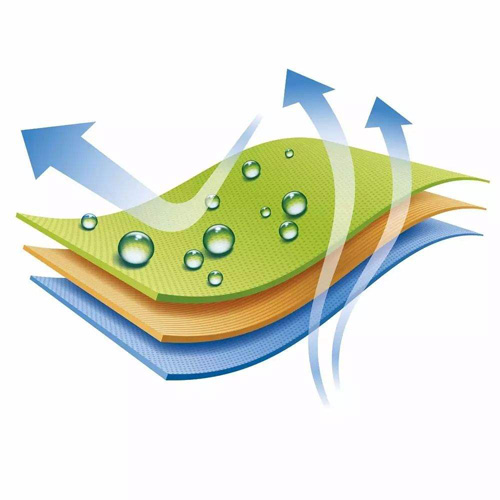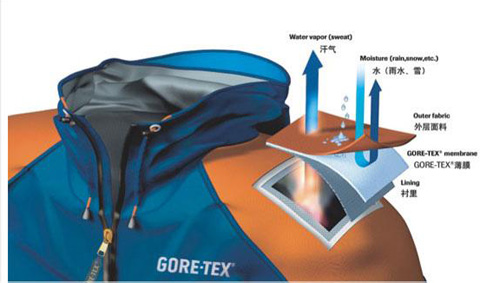Research on PTFE waterproof and breathable laminated fabric
Research on PTFE waterproof and breathable laminated fabrics
Waterproof and moisture-permeable laminated composite fabrics use lamination technology to combine ordinary textile fabrics with high-tech microporous films, complementing each other’s strengths and integrating a variety of excellent properties, which can effectively solve the contradiction of being both waterproof and moisture-permeable. Compared with high-density fabrics and coated fabrics, it has obvious technical advantages, fully demonstrates the characteristics of differentiation and functionality of the times, and is the main development direction of waterproof and breathable fabrics at present.
The American Gore Company’s Yihehe Company is currently recognized as a representative product of “waterproof and breathable”. A film is mainly composed of polytetrafluoroethylene (hereinafter referred to as biaxially stretched microporous film). It is about 100 meters thick, has an opening ratio of 100 meters, and a pore diameter of about 100 meters. It is about the size of a water droplet and is several times larger than a water vapor molecule. Its water pressure resistance can reach up to The moisture permeability is greater than,·, and the air permeability is less than “·, so it has good waterproof, moisture permeability, and windproof functions. The film is a solid body without micropores made of hydrophilic polyester block polymer, and its thickness is only , has the advantages of light weight, soft feel and short diffusion distance of water vapor from the inside to the outside. It is powerful when used in sportswear and casual wear, and can meet more requirements in outdoor and harsh weather clothing.

After several years of hard work, we completed the physical analysis, data research, analysis and demonstration and sample trial production of a fabric in the United States to study the technical approach to the localization of a fabric, and achieved a comprehensive breakthrough in this technology in a short period of time. This is of great significance for seizing the international “commanding heights”, narrowing the gap between our army and foreign armies in protective materials, and promoting its application in labor protection clothing. Microporous film production technology The film technology mainly includes calendering film, turning film and stretch film. According to relevant literature and multiple film-making experiments, only stretched films have a good microporous structure.
The production process of biaxially stretched microporous membranes includes resin lubricant mixed compact pressing, extrusion, calendering, drying, longitudinal stretching and transverse stretching to form the finished membrane. The resin components are mixed in the form of a dispersion, dehydrated and dried, then appropriate lubricant is added to form a mold base, which is pushed, extruded, calendered and then dried. The lubricant is removed under a certain tension to form a base belt with pores. At this time, the pores in the membrane are small and the porosity is also low, only. These base tapes exist in a microfiber structure. When the base tape is stretched at a certain temperature, the resin microfibers are stretched and oriented. Pores are formed between microfibers, and the connections between fiber bundles are nodes. The size of the pores between microfibers determines the size of the pores, and the number and size of nodes affect the porosity. Due to its physical properties, the film at this time has poor dimensional stability and low strength. It will shrink significantly if left for a long time, making it not very practical.
After heat setting, the microporous structure can be maintained, and the dimensional stability and strength will be greatly improved. Microporous films used on waterproof and breathable laminated fabrics should have high porosity and strength. The factors that affect the strength are mainly related to the strength of the film when it is extruded by the injection molding machine and is not yet shaped. , film strength is related to speed, temperature and time during the stretching process. 2. Film strength is related to the crystallinity of the film after stretching. The film strength is related to the degree of chain linkage of amorphous areas in the material. When the above factors are adjusted to the optimal level, the tensile strength of the membrane can be as high as 100% or even higher, the porosity can also be as high as possible, and the crystallinity can be as high as 10%. The process of making films by stretching method is long, and various factors in the process have an impact on the pore size and porosity, such as raw material formula, rolling ratio, heat treatment conditions, stretching conditions, etc. Through experiments, it was found that the influence of stretching conditions on pore size and porosity is greater than that of stretching temperature. As the temperature increases, the pore size and porosity of the stretched film increase. Second, the stretching distance is larger. The pore diameter becomes smaller, and the porosity also becomes smaller accordingly.

Regardless of the stretching ratio and pore diameter, the porosity increases with the increasing stretching ratio. After heat setting, as the temperature increases and the time increases, the pore size and porosity decrease. Laminated fabric composite process test Laminated product material selection and structural design Depending on the end use, laminated fabrics can choose different fibers and fabric structures, films with different functions and different composite methods. Film micropore size and pore size distribution And the opening rate directly affects the waterproofness, moisture permeability, windproof and thermal insulation properties of the composite laminated fabric. Depending on the product, we make the microporous film into three types: high waterproof and low moisture permeability type, medium waterproof and medium moisture permeability type, and low waterproof and high moisture permeability type to balance the waterproofing and moisture permeability in different use occasions. contradiction.
Fabric fabrics and linings can be made of woven fabrics or knitted fabrics, or non-woven fabrics or wadding according to different uses. The fabrics used can be natural fibers such as cotton and wool, or pure or blended fabrics of chemical fibers such as polyester and nylon. As the outer fabric, it is best to use woven fabrics. To improve water resistance, the surface fabric should be treated with a water-repellent finish. The finishing effect should be above the water repellency level. According to the requirements, functional fabrics such as camouflage, flame retardant, anti-static, oil and water repellent, easy to remove dirt, and acid and alkali resistance can be used. Structural design of laminated fabrics Depending on the end-use needs, laminated fabrics can adopt different structural designs and composite layers. Two-story complexThe reason why fabrics are rarely used. In March 2019, at the request of the Polar Expedition Office of the State Oceanic Administration, we produced laminated fabric cold-proof clothing for the Antarctic scientific expedition team members. The low temperature is 1 and the high wind speed is 1.
The scientific expedition team members reported that the laminated clothing is warm, wind-resistant, and snow-proof, and the outer layer prevents oil penetration. During the inspection activities, because the outerwear and underwear were properly matched, they felt moisture-permeable and sweat-free, with no sticky or hot feeling, and no cold or clammy feeling after stopping the activity. They were comfortable to wear and soft and wear-resistant in cold climate conditions. Application Prospects Based on small sample tests, expanded tests and trial production, laminated fabrics will be put into mass production at the end of the year, and the price is only one-half the price of similar foreign products. Laminated fabric is currently the best waterproof and breathable fabric in the world in all aspects and has a wide range of uses. Overseas, it has been used in military protective clothing, tents, mountaineering clothing, astronaut all-weather sportswear, sports shoes, gloves, medical surgical clothing, etc. in extreme cold areas. Lamination made by changing the filmmaking process, fabric substrate and adhesive Fabrics are also widely used in industry, such as air ultra-clean dust removal filter materials, liquid filter materials, permeable membranes, etc.
Film making equipment, composite equipment and composite fabrics have reached international standards, filling a domestic gap. Its technology breaks the monopoly of foreign companies. After nationwide promotion, it can improve the quality of domestic waterproof and breathable fabrics and drive the development of a number of related industries. v9cZ1rb6Z4
Disclaimer:
Disclaimer: Some of the texts, pictures, audios, and videos of some articles published on this site are from the Internet and do not represent the views of this site. The copyrights belong to the original authors. If you find that the information reproduced on this website infringes upon your rights, please contact us and we will change or delete it as soon as possible.
AA








